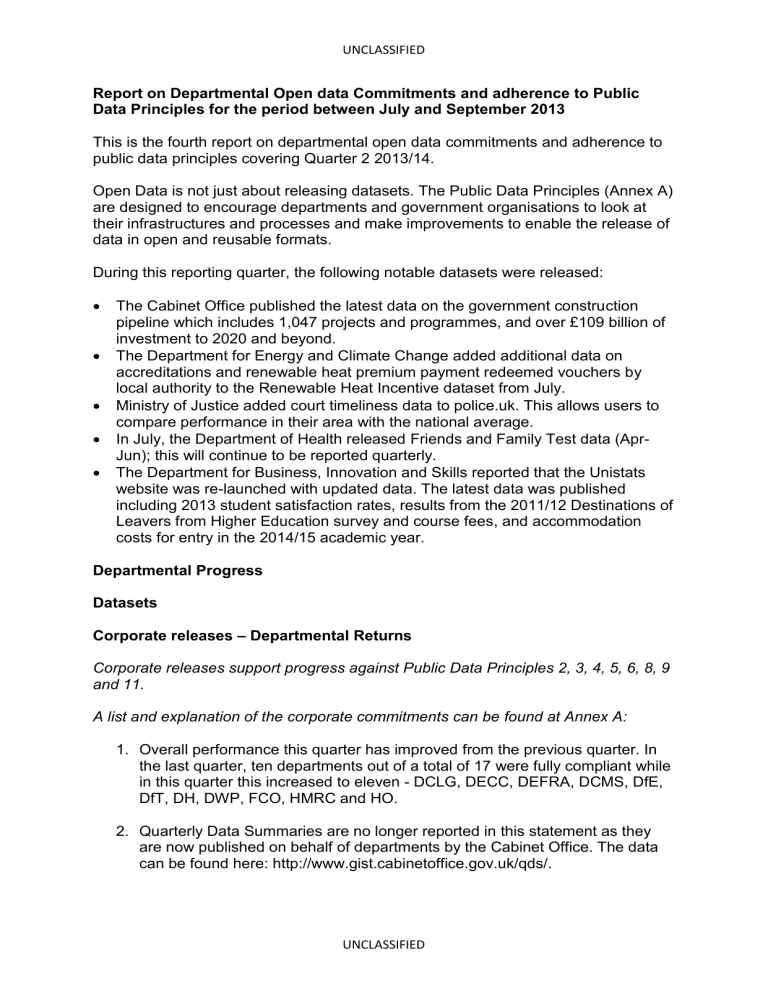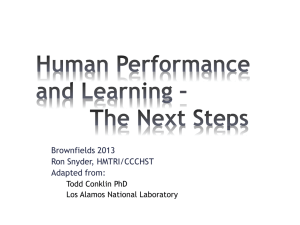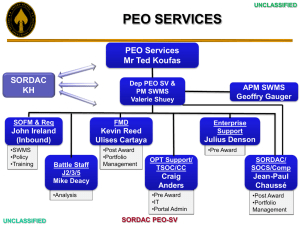Open Data and Transparency QWMS_Q2 2013_14 for

UNCLASSIFIED
Report on Departmental Open data Commitments and adherence to Public
Data Principles for the period between July and September 2013
This is the fourth report on departmental open data commitments and adherence to public data principles covering Quarter 2 2013/14.
Open Data is not just about releasing datasets. The Public Data Principles (Annex A) are designed to encourage departments and government organisations to look at their infrastructures and processes and make improvements to enable the release of data in open and reusable formats.
During this reporting quarter, the following notable datasets were released:
The Cabinet Office published the latest data on the government construction pipeline which includes 1,047 projects and programmes, and over £109 billion of investment to 2020 and beyond.
The Department for Energy and Climate Change added additional data on accreditations and renewable heat premium payment redeemed vouchers by local authority to the Renewable Heat Incentive dataset from July.
Ministry of Justice added court timeliness data to police.uk. This allows users to compare performance in their area with the national average.
In July, the Department of Health released Friends and Family Test data (Apr-
Jun); this will continue to be reported quarterly.
The Department for Business, Innovation and Skills reported that the Unistats website was re-launched with updated data. The latest data was published including 2013 student satisfaction rates, results from the 2011/12 Destinations of
Leavers from Higher Education survey and course fees, and accommodation costs for entry in the 2014/15 academic year.
Departmental Progress
Datasets
Corporate releases
– Departmental Returns
Corporate releases support progress against Public Data Principles 2, 3, 4, 5, 6, 8, 9 and 11.
A list and explanation of the corporate commitments can be found at Annex A:
1. Overall performance this quarter has improved from the previous quarter. In the last quarter, ten departments out of a total of 17 were fully compliant while in this quarter this increased to eleven - DCLG, DECC, DEFRA, DCMS, DfE,
DfT, DH, DWP, FCO, HMRC and HO.
2. Quarterly Data Summaries are no longer reported in this statement as they are now published on behalf of departments by the Cabinet Office. The data can be found here: http://www.gist.cabinetoffice.gov.uk/qds/.
UNCLASSIFIED
UNCLASSIFIED
3. The table below shows progress departments have made on a range of data they committed to publish by the end of the reporting quarter. The measurement of ‘met’ or ‘not met’ denotes whether the expected publications were available at the end of the reporting quarter. A mea surement of ‘not met’ merely indicates that the expected data was not publically available at the end of September 2013 – the data may have been published in the interim period between the end of September 2013 and the publication date of this report.
An explanation of each of the reporting categories can be found at Annex B.
BIS CO DCLG DECC DEFRA DCMS DfiD DfE DfT DoH DWP FCO HMRC HMT HO MOD MoJ
Spend data
GPC data
Organogram
Not
Met
Not
Met
Met Met
Met
Not
Met
Met Met
Not
Met
Met Met Met
Met
Met
Met
Met Met Met Met Met Met Met Met
Not
Met
Met Met
Not
Met
Met Met Met Met Met Met Met Met
Not
Met
Met Met
Not
Met
Met
Not
Met
Met Met Met Met Met Met Met Met Met Met
Exceptions to
Moratoria (ICT,
Property,
Recruitment,
Marketing &
Consultancy)
Workplace
Management
Information
Met
Not
Met
Met Met Met
Met Met Met Met Met
Met Met Met Met Met Met Met Met Met Met Met Met
Met Met Met Met Met Met Met
Not
Met
Met Met Met
Ministers’, Gifts, hospitality received, overseas travel, Meetings with external organisations including media executives
Met Met Met Met
Special Advisers
Gifts and
Hospitality and meetings with media executives
Senior Officials
Expenses, Travel and Hospitality
Permanent secretaries meetings with external organisations including media executives
Contract Finder
Met
Met
Met
Met
Met
Met
Met
Met
Met
Met
Met
Met
Met
Met
Met
Met
Real Time Energy
User
Met Met Met Met
Met
Met
Met
Met
Met
Met
Met Met Met Met Met Met Met
Met Met Met Met Met Met Met
Met Met Met Met Met Met Met Met
Met Met Met Met Met Met Met Met
Met Met Met Met Met Met Met Met
Met Met Met Met Met Met Met Met
Met
Met
Met
Met
Met
Met
Met
Met
Met Met
Not
Met
Met
Met Met Met Met
Met Met Met Met
Met Met Met Met
UNCLASSIFIED
UNCLASSIFIED
4. BIS reported that the department is transitioning to a new management information system. During the transition period they were unable to provide current or refreshed data. As soon as the data becomes available, the reports detailing staff numbers and paybill costs will be published.
5. CO reported publication of spend data (£25K+ and GPC expenditure) was delayed. Latest data on spending approvals (exceptions to moratoria) was published on time on http://www.gist.cabinetoffice.gov.uk/oscar/ but not made available on data.gov.uk.
6. DFID reported that their organogram was published and amended for March
2013, however the data that came off the system contained a few errors. This was difficult to fix as the data cannot simply be overwritten. This meant that the data was not complete by the end of the period but it has subsequently been published on data.gov.uk. Future organograms will use data extracted from DFID's brand new "HR Passport" system. This should make the process simpler in future and a new organogram will be uploaded by the end of Q3
2013/14.
7. HMT reported that the publication of spend over £25,000 and GPC data was delayed. The Workforce Management data was published late due to internal problems with access to data.gov.uk. This is expected to be resolved as HMT has arranged for more staff to have access to data.gov.uk.
8. MOD reported delays in the data collection for senior officials’ expenses, travel and hospitality data pending verification of some expenditure from appointments and external sources [e.g. HMRC]. MOD hopes to be in a position to publish shortly.
9. MoJ has not met the target for publ ication of spend of over £25,000 and GPC data. They report that work to update their transparency data in these areas is ongoing and that it will be published in due course.
Published Commitments
Published Commitments supports progress against Public Data Principles 1, 2, 3, 4,
5, 8, 9, 10, 11, 12.
10. BIS reported that, on 19 September, the Unistats website (which allows prospective higher education students to compare the Key Information Set) was re-launched with updated data. A number of changes were introduced to improve the usability and accessibility of the website including a new mobilecompatible version of the site. The latest data was also published including
2013 student satisfaction rates, results from the 2011/12 Destinations of
Leavers from Higher Education survey and course fees and accommodation costs for entry in the 2014/15 academic year.
11. CO reported that in August they published the latest data on the government construction pipeline which includes 1,047 projects and programmes, and
UNCLASSIFIED
UNCLASSIFIED over £109 billion of investment to 2020 and beyond. In September they published data derived directly from the Cabinet Office Annual Report and
Accounts 2012-13 (for the year ended 31 March 2013); this was first published on the Cabinet Office website in July 2013. This is the second successive year they have published this data on www.data.gov.uk and they remain one of the few departments to publish all underlying Annual Accounts data in full and in an open format.
12. DCMS published statistics from the Taking Part survey. Data from Q1
2013/14 was published on 26 September 2013: https://www.gov.uk/government/publications/taking-part-201314-quarter-1statistical-release
13. DECC has met all of its Open Data Strategy commitments. Additional data on accreditations and Renewable Heat Premium Payment redeemed vouchers by local authority was included in the Renewable Heat Incentive dataset from
July.
14. DfE reported numerous data releases during the quarter. On 16 July 2013, it published academy spend tables containing information on academies’ income and expenditure for the academic year 2011/2012. DfE want to encourage academies to use the data to benchmark themselves against each other. The data release also enables parents and the wider public to compare the spending and performance of academies in their local area. DfE also released the underlying data for their April publication of the ‘School
Workforce in England, November 2012’ Statistical First Release. The underlying data includes over 40 school level school workforce indicators that provide data users with information on school size (staff numbers by type), characteristics, qualifications and pay of school teachers, as well as details on teacher sickness absence and teaching vacancies.
15. DH reported that they had released diagnostic imaging data linked to hospital episodes statistics. This was available as a standard data linkage for the first time in September 2013. In July, DH released Friends and Family Test data
(Apr-Jun); this will continue to be reported quarterly. They also published
Health Care Associated Infections (by type of infection) data which will be updated monthly on an ongoing basis.
16. DWP reported that they had published National Insurance Number registrations to adult overseas nationals entering the UK via Stat-Xplore in
September 2013. The data is made available under Open Government
Licence. New Work Programme data was also released in September, showing the proportion of customers for whom providers have received a Job
Outcome payment at 24 months.
17. FCO reported that they continue to make progress on publication of the ODA spend in line with IATI standards, including publishing a number of project evaluation documents.
UNCLASSIFIED
UNCLASSIFIED
18. HMRC has continued to release transparency datasets on time including air travel data, HMRC officials ’ meetings with the tobacco industry and performance reports.
19. MOJ reported that National Archive contracts above £10,000 are now available to view on the 'contracts finder' website. Court timeliness data has also been added to police.uk, allowing users to compare performance in their area with the national average.
Arm ’s Length Bodies Progress
ALB reporting supports progress against Public Data Principles 1, 2, 3, 4, 5, 8, 9, 10,
11, 12
20. BIS reported that, in order to build on the successful dataset delivery by partners, the Department has created a community of practice through an approved Extranet application. This community will share best practice across the BIS family which will enable BIS to encourage greater compliance with the transparency agenda. BIS reported that the Land Registry published the
INSPIRE Index Polygons Service; this is a Web Mapping Service providing map images to over 21 million land and property extents. As part of the
Technology Strategy Board’s ‘Solving Business Problems with Environmental
Data’ competition, the Met Office attended eight workshops and led a number of hackathons and data-user competitions including FOSS4G and the Global
Geohack, in cities across the country. These competitions focused on themes of Energy, Transport, Built Environment, Agriculture and Food and Financial
Services. Met Office representatives have attended and spoken at these events to raise awareness of DataPoint and other Environmental Science to
Service Partnership available datasets.
The Land Registry Open Data Challenge was launched, offering individuals, entrepreneurs and small businesses the opportunity to compete for a monetary award to fund innovative uses of Land Registry data.
The challenge will run until October and culminate in an award ceremony in November. It is hoped that the challenge will improve the understanding of how Land Registry data can contribute to social and business innovation. The use of financial measures as part of the judging criteria also aims to increase awareness of the potential economic value of Land Registry data. Following further enhancements, Historical Price Paid Data was also re-released in (W3)
Linked Data format.
Through the Technology Strategy Board, BIS is providing vouchers of up to
£5000 to companies to develop new business ideas using open data. In
Round 4, which closed in July, over 30 vouchers were granted. To date this financial year, over 100 vouchers have been granted.
In July, the midata Innovation Lab (http://www.midatalab.org.uk/) was launched to engage 1,000 volunteers on their attitudes to data and how it is
UNCLASSIFIED
UNCLASSIFIED used, collaborating with a number of businesses and the Open Data Institute.
The Innovation Lab is currently working to drive up numbers of data donors and developers. The midata team are also talking to the ODI, HMRC and others about the future funding, role and use of this data.
21. DCLG reported that their ALBs published organograms on data.gov.uk and their own websites. DCLG sponsored ALBs now go beyond Cabinet Office requirements by publishing all items of spend over £250, including GPC spend from September 2012. Three quarters of DCLG ALBs will be covered by 'Public Bodies 2013', which publishes information including Terms of
Reference, government funding, expenditure and names and remuneration of
Chief Executives and Chairs.
22. DCMS reported that compliance with open data corporate commitments remains generally good throughout their ALBs. DCMS has started an exercise to improve transparency compliance with results likely to be visible from
March 2014 onwards.
23. DECC has provided details on which data should be made available on data.gov.uk to its ALBs and will continue to work with them and monitor progress through quarterly SIRO meetings. They are also working with
Cabinet Office to ensure that ALBs have appropriate permissions to make data available on data.gov.uk and Cabinet Office has agreed to run a briefing session for ALBs. DECC is working with the Coal Authority to make more of their data available through data.gov.uk. The Committee on Climate Change
(CCC) launched a new website in April and is using this to publish transparency data. DECC is working with CCC’s Secretariat to make this data available through data.gov.uk.
24. DEFRA reported that, as part of the revised collection and approvals process, corporate spend data supplied by their ALBs is now being received and processed in a timely manner.
25. DFID has three ALBs, two of which they judge to be in scope. Both of these organisations have published datasets on data.gov.uk in the last quarter for the first time. CDC also publishes open data in line with the International Aid
Transparency Initiative's open data standard. The Independent Commission on Aid Impact is an independent body and publishes all of its reports and accounts online including an annual report, but it does not publish its data on data.gov.uk.
26. DfT ’s ALB compliance has been aided by increased liaison between DfT and the ALBs. The Executive Agencies (such as Highways Agency and DVLA) have always been fully within scope but the ALBs are now also largely publishing their data on data.gov.uk.
27. DH are continuing to liaise with the ALBs that became fully functional on 1
April 2013 in order to ensure that they are aware of the requirements of the transparency agenda and to support them in delivering open data. The vast
UNCLASSIFIED
UNCLASSIFIED majority of DH’s non-corporate open data and transparency commitments are delivered by their ALBs, in particular the Health and Social Care Information
Centre, NHS England and Public Health England. The next meeting with
ALBs is planned for January to explain and work through how they are expected to contribute to open data and transparency.
28. DWP report that the following ALBs publish all mandatory corporate publications, including organogram and GPC spend data: Health and Safety
Executive, Industrial Injuries Advisory Council, Independent Living Funds, The
Pensions Regulator, Pensions Ombudsman, The Pensions Advisory Service and the Social Security Advisory Committee. Their ALBs also continue to publish data more widely and have contributed to the inventory of unpublished datasets.
29. FCO report that their ALBs are fulfilling their obligations where it is appropriate and possible given national security constraints. They also made significant contributions to the inventory of unpublished datasets.
30. HMRC's executive agency, the Valuation Office Agency (VOA) has continued to publish data relating to Council Tax and Non-Domestic Rating Lists online.
They also make the Non-Domestic Rating Lists available as datasets and have released further statistics.
31. HO report that the Disclosure and Barring Service have released a significant amount of data relating to their business processes, functions and performance during the past quarter. This includes the Barring List Data and
DBS Certificates with PNC information, Adult and Child List Information; this is from 2002 to the present day.
32. MOD report that further communication with ALBs has taken place to enhance previous relationships and to assist with future publication of transparency datasets.
Building Capacity
Building Capacity supports all Open Data standards.
33. BIS reported that EITI Champion and Business Minister Jo Swinson launched the UK Extractive Industries Transparency Initiative (EITI) on the 9th July at the BIS Conference Centre. Over 130 representatives from industry, civil society and government departments attended the event which included speeches from Jo Swinson and the Rt. Hon. Clare Short, Chair of the
International EITI Board. In September, Minister of State for Universities and
Science, Rt. Hon David Willetts chaired a meeting of the Research Sector
Transparency Board, at which the board discussed the risks around a lack of coordination and standardisation across institutional repositories, and the challenge of looking for data across disciplinary boundaries. To seek practical
UNCLASSIFIED
UNCLASSIFIED ways forward, the Royal Society agreed to convene an “Open Science Data
Forum”, to be held in early 2014. The aim of the Forum will be to engage the parties who would be key to the implementation of an open data regime in research, including representatives of universities, the Research Councils, and other experts.
34. DCLG have continued to extend the range and volume of data published via their Open Data Communities service in fully accessible, 5-star formats. In this quarter they published significant additional content for house building completions (see http://opendatacommunities.org/data/housebuilding/completions/tenure). The LGA’s LG Inform is now integrated with
Open Data Communities and is retrieving data directly over the web, removing the need for processing separate spreadsheets. DCLG has also been working with local authorities such as Hampshire County Council and its
‘Hampshire Hub’ project which exploits opportunities for linking DCLG data with local data. The first outputs of this are available at protohub.net.
35. DfT reported that work continues on its two major initiatives for 2013-14 as set out in the DfT Business Plan. The first is the A14 corridor study in conjunction with the Technology Strategy Board and partners from the public and private sector. This project aims to harvest, process and re-use public and private data to assess the potential impact on road-users, infrastructure efficiency and critical decision making. The second is to work with Transport for London to attempt to embed the Travel Demand Management principles from London
2012 into the day-to-day operation of the infrastructure in London, initially focussing on the London Bridge development work.
36. DH announced plans in August to develop a modern data system for the health and care system, care.data. This system will also provide data for multiple uses, including large aggregated anonymised datasets as open data, in due course.
37. DWP Open Data Group (formerly External Stakeholder Group) has been refreshed with revised Terms of Reference and the number of external data users has increased from 8 to 15 members. A meeting was held on the 26th
September and minutes were published on the DWP Transparency website.
The Energy and Environment Open Data Policy workshop was held in
September. DWP attended to cover DWP data sharing with DECC and energy providers to tackle fuel poverty. The Work Programme Official
Statistics public consultation paper was published in August 2013, providing recommendations for an improved method of presenting DWP's Work
Programme data and seeking views on the overall presentation, and content.
Feedback will be assessed and responses provided along with any implementation dates for changes in the next quarter.
38. FCO published a refresh of its Open Data Strategy signifying a renewed commitment to Open Data and Transparency from the department. In addition
UNCLASSIFIED
UNCLASSIFIED to identifying areas of data that they intend to release, it commits FCO to better engagement with data users and to release everything in 3* or above as standard.
39. HMRC ’s consultation on proposals for the sharing and publication of their data in order to deliver wider public benefits closed on 24 September. At the end of the period, the department was analysing the responses.
40. HO continues to work with the Open Data Institute and recently supported the
‘Crime and Justice’ strand of the Immersion Programme. Where possible, they will support those developers successful in receiving funding from the
ODI.
Publication of inventories of unpublished datasets
41. As part of the government response to the Shakespeare Review of Public
Sector Information, the government agreed to publish an inventory of all of the datasets that each department, including their ALBs and agencies, hold. The first iteration of the inventory of currently unpublished government data was published on data.gov.uk on 2 nd September with departments adding to this over the following weeks. By the end of the quarter, departments and their
ALBs had published the following:
Department
BIS
CO
DCLG
DECC
DEFRA
DCMS
DfiD
DfE
DfT
DoH
DWP
FCO
HMRC
HMT
HO
MOD
MoJ
Unpublished datasets
358
107
96
40
1211
68
54
182
521
112
389
151
197
6
45
403
84
Published datasets
1234
73
847
57
825
169
21
451
206
2503
175
40
77
41
251
311
196
UNCLASSIFIED
UNCLASSIFIED
Open Government Partnership
42. The Cabinet Office Transparency Team was heavily engaged in preparations for the Open Government Partnership (OGP) Annual Summit, which was held on 31 st October and 1 st November. We used this opportunity to lobby countries to make ambitious new commitments to open government, including by adopting the Open Data Charter, which was drafted under the UK’s
Presidency of the G8 and agreed by G8 leaders in June.
43. We continued to support engagement between the UK and overseas governments to secure membership of the OGP. The Minister for the Cabinet
Office visited Morocco, Tunisia and India during this quarter.
Data.gov.uk
44. Data.gov.uk development team delivered the location-based search tools.
These were fully usable by the end of Q2 2013/14.
45. The team also created a feedback form which enables users to provide input on any of the datasets on data.gov.uk. This was launched to coincide with the publishing of departments’ dataset inventories on 2 nd of September. Users can use this to assess the datasets ’ potential impact on the UK government, economy and society and note whether the datasets contain data which could potentially link to other datasets.
46. The team also continued to work on the migration to the new site platform which was launched to coincide with the Open Government Partnership
Conference on 31 st October 2013.
UNCLASSIFIED
UNCLASSIFIED data.gov.uk Analysis
Site Usage for Q2 2013/14
Total page views
1399435
Total visits
446470
Pages per visit 3.13
Average time on site 2 mins 19 secs
Bounce rate (home page)
New visits
35.74%
74.00%
Most popular datasets during Q2 2013/14
July August September
Total for
Q2
2013/14 Dataset
Bona Vacantia
Unclaimed Estates and
Adverts
English Indices of
Deprivation 2010
Lower Layer Super
Output Area (LSOA) boundaries
Government construction pipeline
4125
2502
2090
121
6755
2281
1821
3698
2132
2132
1523
415
13012
6915
5434
4234
Building Price and Cost
Indices
Road Safety Data
VAT registered businesses
Social Trends
National Public
Transport Access Nodes
(NaPTAN)
Code-Point Open
1307
689
1444
1045
1009
1342
1264
2159
1230
775
881
740
1516
860
1002
1355
813
511
4087
3708
3676
3175
2703
2593
UNCLASSIFIED
UNCLASSIFIED
Annex A
Public Data Principles
1. Public data policy and practice will be clearly driven by the public and businesses that want and use the data, including what data is released when and in what form.
2. Public data will be published in reusable, machine-readable form.
3. Public data will be released under the same open licence which enables free reuse, including commercial reuse.
4. Public data will be available and easy to find through a single, easy-to-use, online access point ( www.data.gov.uk
).
5. Public data will be published using open standards, and following relevant recommendations of the World Wide Web Consortium (W3C).
6. Public data from different departments about the same subject will be published in the same, standard formats and with the same definitions.
7. Public data underlying the Government’s own websites will be published in reusable form.
8. Public data will be timely and fine-grained.
9. Release data quickly, and then work to make sure that it is available in open standard formats, including linked data forms.
10. Public data will be freely available to use in any lawful way.
11. Public data will be available without application or registration, and without requiring details of the user.
12. Public bodies should actively encourage the reuse of their public data.
13. Public bodies should maintain and publish inventories of their data holdings.
14. Public bodies should publish relevant metadata about their datasets and this should be available through a single online access point; and they should publish supporting descriptions of the format provenance and meaning of the data.
UNCLASSIFIED
UNCLASSIFIED
Annex B
Corporate Commitments
Commitment
Spend data
GPC data
Organogram
Description
Monthly publication of all expenditure over £25,000 including a plain English description (1 month in arrears)
Monthly publication of all expenditure over £500 on the Government Procurement Card (2 months in arrears)
6-monthly publication of posts, salaries and job descriptions within each department. Full disclosure including name of post holder for those at Senior
Civil Service payband 2 (or equivalent) and above
Exceptions to Moratoria (ICT,
Property, Recruitment, Marketing &
Consultancy)
Workplace Management
Information
Quarterly publication of any exceptions to the current government restrictions on spend on ICT, consultancy, recruitment, property, consultancy, advertising and marketing.
Monthly management information on staff numbers and paybill costs in Civil Service departments, their agencies and their executive NDPBs.
Ministers’, Gifts (given and received), hospitality received, overseas , Travel, Meetings with external organisations including senior media executives
Quarterly detail on travel, hospitality, gifts and meetings with external companies for Ministers
Senior Officials Expenses, Travel and Hospitality
Permanent secretaries meetings with external organisations including senior media executives
Special Advisers Gifts and
Hospitality received and meetings with senior media executives
Contract Finder
Real Time Energy User
Quarterly detail on expenses, travel and hospitality for Senior Officials
Quarterly detail on meetings with external organisations including senior media executives for
Permanent Secretaries
Quarterly detail on hospitality, gifts and meetings with external companies for Special Advisors
Online publication of all new tenders and contracts awarded over £10,000, including PIN notices
Central government departments would publish online the real-time energy use of their headquarter buildings. Most of the real-time energy displays provide energy data in half hourly intervals, and are published on departmental websites with a delay of no more than 24 hours
UNCLASSIFIED








